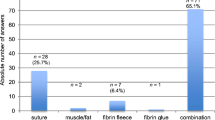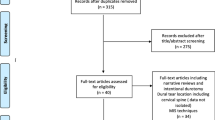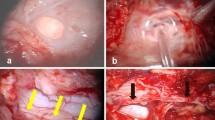Abstract
Background
Although it is generally accepted that incidental durotomies (ID) should be primarily repaired, the current literature shows no consensus regarding the peri- and postoperative management in case of ID during lumbar spine surgery. Because ID is a rather frequent complication and may be associated with significant disability, we were interested to analyze the current handling of ID in three European countries.
Methods
In March 2014, members of the Swiss, German, and Austrian neurosurgical and spine societies were asked to complete an online questionnaire regarding the management of ID during and after lumbar spine surgery. Two, respectively 4 weeks after the first invitation, reminder requests were sent to all invitees, who had not already responded at that time.
Results
There were 175 responses from 397 requests (44.1 %). Responders were predominantly neurosurgeons (89.7 %; 10.3 % were orthopedic surgeons), of which 45.7, 40.0, and 17.8 % work in a non-university hospital, university hospital, and private clinic, respectively. As for the perioperative management of ID, 19.4 % of the responders suggest only bed rest, while, depending on the extent of the ID, 84.0 % suggest additional actions, TachoSil/Spongostan with fibrin glue or a similar product and single suture repair being the most mentioned. Concerning epidural wound drainage in case of ID, 37.2 % desist from placing an epidural wound drainage with or without aspiration, 30.9 % place it sometimes, and 33.7 % place it regularly, but only without aspiration. Most responders prescribe bed rest for 24 (34.9 %) or 48 h (28.0 %), with much fewer prescribing bed rest for 72 h (6.3 %) and none more than 72 h, and 14.9 % of participants never prescribe bed rest. The vast majority of physicians (82.9 %, n = 145) always inform their patients after the operation in case of ID.
Conclusions
There is substantial heterogeneity in the management of incidental durotomies. The majority of spine surgeons today aim at complete/sufficient primary repair of the ID with varying recommendations concerning postoperative bed rest. Still, there is a trend towards early mobilization if the incidental durotomy has been closed completely/sufficiently with no participant favoring bed rest for more than 72 h.
Similar content being viewed by others
References
Deyo RA, Cherkin DC, Loeser JD, Bigos SJ, Ciol MA (1992) Morbidity and mortality in association with operations on the lumbar spine. The influence of age, diagnosis, and procedure. J Bone Joint Surg Am 74:536–543
Kalevski SK, Peev NA, Haritonov DG (2010) Incidental dural tears in lumbar decompressive surgery: incidence, causes, treatment, results. Asian J Neurosurg 5:54–59
Tafazal SI, Sell PJ (2005) Incidental durotomy in lumbar spine surgery: incidence and management. Eur Spine J 14:287–290
Baker GA, Cizik AM, Bransford RJ, Bellabarba C, Konodi MA, Chapman JR, Lee MJ (2012) Risk factors for unintended durotomy during spine surgery: a multivariate analysis. Spine J 12:121–126
Jankowitz BT, Atteberry DS, Gerszten PC, Karausky P, Cheng BC, Faught R, Welch WC (2009) Effect of fibrin glue on the prevention of persistent cerebral spinal fluid leakage after incidental durotomy during lumbar spinal surgery. Eur Spine J 18:1169–1174
Khan MH, Rihn J, Steele G, Davis R, Donaldson WF 3rd, Kang JD, Lee JY (2006) Postoperative management protocol for incidental dural tears during degenerative lumbar spine surgery: a review of 3,183 consecutive degenerative lumbar cases. Spine 31:2609–2613
McMahon P, Dididze M, Levi AD (2012) Incidental durotomy after spinal surgery: a prospective study in an academic institution. J Neurosurg Spine 17:30–36
Stromqvist F, Jonsson B, Stromqvist B, Swedish Society of Spinal S (2010) Dural lesions in lumbar disc herniation surgery: incidence, risk factors, and outcome. Eur Spine J 19:439–442
Williams BJ, Sansur CA, Smith JS, Berven SH, Broadstone PA, Choma TJ, Goytan MJ, Noordeen HH, Knapp DR, Hart RA, Zeller RD, Donaldson WF, Polly DW, Perra JH, Boachie-Adjei O, Shaffrey CI (2011) Incidence of unintended durotomy in spine surgery based on 108,478 cases. Neurosurgery 68:117–123
Desai A, Ball PA, Bekelis K, Lurie J, Mirza SK, Tosteson TD, Weinstein JN (2011) SPORT: does incidental durotomy affect long-term outcomes in cases of spinal stenosis? Neurosurgery 69:38–44
Sin AH, Caldito G, Smith D, Rashidi M, Willis B, Nanda A (2006) Predictive factors for dural tear and cerebrospinal fluid leakage in patients undergoing lumbar surgery. J Neurosurg Spine 5:224–227
Takahashi Y, Sato T, Hyodo H, Kawamata T, Takahashi E, Miyatake N, Tokunaga M (2013) Incidental durotomy during lumbar spine surgery: risk factors and anatomic locations: clinical article. J Neurosurg Spine 18:165–169
Guerin P, El Fegoun AB, Obeid I, Gille O, Lelong L, Luc S, Bourghli A, Cursolle JC, Pointillart V, Vital JM (2012) Incidental durotomy during spine surgery: incidence, management and complications. A retrospective review. Injury 43:397–401
Cammisa FP, Girardi FP, Sangani PK, Parvataneni HK, Cadag S, Sandhu HS (2000) Incidental durotomy in spine surgery. Spine 25:2663–2667
Desai A, Ball PA, Bekelis K, Lurie J, Mirza SK, Tosteson TD, Zhao W, Weinstein JN (2012) Surgery for lumbar degenerative spondylolisthesis in spine patient outcomes research trial: does incidental durotomy affect outcome? Spine 37:406–413
Desai A, Ball PA, Bekelis K, Lurie JD, Mirza SK, Tosteson TD, Weinstein JN (2011) Outcomes after incidental durotomy during first-time lumbar discectomy. J Neurosurg Spine 14:647–653
Wang JC, Bohlman HH, Riew KD (1998) Dural tears secondary to operations on the lumbar spine. Management and results after a two-year-minimum follow-up of eighty-eight patients. J Bone Joint Surg Am 80:1728–1732
Espiritu MT, Rhyne A, Darden BV (2010) Dural tears in spine surgery. J Am Acad Orthop Surg 18:537–545
Miscusi M, Polli FM, Forcato S, Coman MA, Ricciardi L, Ramieri A, Raco A (2014) The use of surgical sealants in the repair of dural tears during non-instrumented spinal surgery. Eur Spine J. 2014. PMID 24384831
Radcliff KE, Sidhu GD, Kepler CK, Gruskay J, Anderson DG, Hilibrand A, Albert TJ, Vaccaro AR (2013) Complications of flat bedrest following incidental dural repair. J Spinal Disord Tech. PMID 23197257
Low JC, von Niederhausern B, Rutherford SA, King AT (2013) Pilot study of perioperative accidental durotomy: does the period of postoperative bed rest reduce the incidence of complication? Br J Neurosurg 27:800–802
Ohana N, Kleir I (2005) Immediate mobilization following incidental durotomy in spine surgery. J Bone Joint Surg (Br) 87-B:379
Eroes CA, Barth C, Tonn JC, Reulen HJ (2008) The revised European neurosurgical electronic logbook of operations. Acta Neurochir (Wien) 150:195–198
Lindsay K (2012) Accreditation of neurosurgical training programmes in Europe: report of JRAAC. Acta Neurochir (Wien) 154:947–949
Omerhodzic I, Tonge M, Matos B, Musabeliu E, Raspanti C, Ferdinandov D, Galimova R, Muroi C, Balik V, Kursumovic A (2012) Neurosurgical training programme in selected European countries: from the young neurosurgeons’ point of view. Turk Neurosurg 22:286–293
Allen C, Glasziou P, Del Mar C (1999) Bed rest: a potentially harmful treatment needing more careful evaluation. Lancet 354:1229–1233
Hodges SD, Humphreys SC, Eck JC, Covington LA (1999) Management of incidental durotomy without mandatory bed rest. A retrospective review of 20 cases. Spine 24:2062–2064
Than KD, Wang AC, Etame AB, La Marca F, Park P (2008) Postoperative management of incidental durotomy in minimally invasive lumbar spinal surgery. Minim Invasive Neurosurg MIN 51:263–266
Aebi M, Grob D (2004) SSE spine tango: a European spine registry promoted by the Spine Society of Europe (SSE). Eur Spine J 13:661–662
Porchet F, Bartanusz V, Kleinstueck FS, Lattig F, Jeszenszky D, Grob D, Mannion AF (2009) Microdiscectomy compared with standard discectomy: an old problem revisited with new outcome measures within the framework of a spine surgical registry. Eur Spine J 18(Suppl 3):360–366
Schluessmann E, Diel P, Aghayev E, Zweig T, Moulin P, Roder C, Group SWR (2009) SWISSspine: a nationwide registry for health technology assessment of lumbar disc prostheses. Eur Spine J 18:851–861
Acknowledgments
The authors of this work thank all participants for having answered this survey.
Conflict of interest
None.
Author information
Authors and Affiliations
Corresponding author
Rights and permissions
About this article
Cite this article
Gautschi, O.P., Stienen, M.N., Smoll, N.R. et al. Incidental durotomy in lumbar spine surgery—a three-nation survey to evaluate its management. Acta Neurochir 156, 1813–1820 (2014). https://doi.org/10.1007/s00701-014-2177-7
Received:
Accepted:
Published:
Issue Date:
DOI: https://doi.org/10.1007/s00701-014-2177-7




